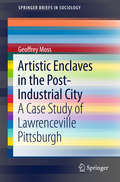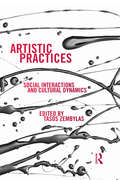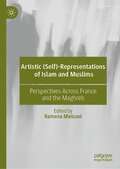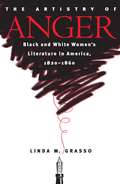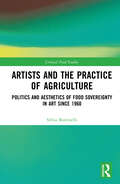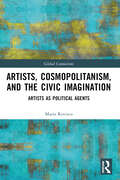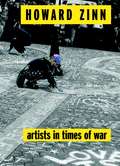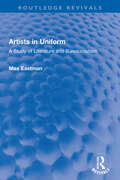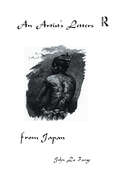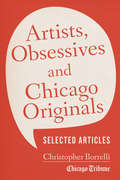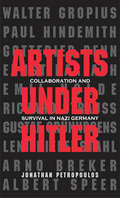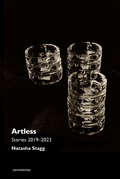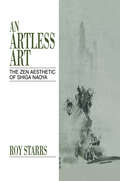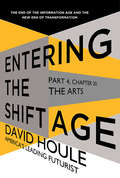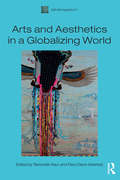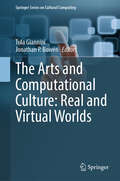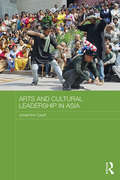- Table View
- List View
Artistic Enclaves in the Post-Industrial City: A Case Study of Lawrenceville Pittsburgh (SpringerBriefs in Sociology)
by Geoffrey MossThis SpringerBriefs presents a case study and theoretical analysis of an artistic enclave that emerged within Lawrenceville Pittsburgh. It briefly describes the history of greater Pittsburgh, and Lawrenceville's transition from thriving blue-collar community to depopulated low-income neighborhood to gentrifying site of artistic and creative culture. It draws on multiple methods (e. g. , interviews, observations, and survey data) to discuss the advantages and disadvantages associated with being a Pittsburgh artist, and offer a detailed description of the origins and ongoing development of Lawrenceville's artistic enclave. It discusses this enclave in the context of sociological, historical, and interdisciplinary work on urban artistic communities (i. e. , bohemian and quasi-bohemian communities), and situates it within the larger urban artistic tradition, and within its contemporary urban context. It maintains that this enclave constitutes a successful (i. e. , sustainable) example of an artistic creative class enclave, a heuristic concept that clarifies and amends Richard Florida's brief commentary on contemporary urban artistic life. It concludes by offering policy suggestions for those who wish to promote such enclaves, and a preliminary critical appraisal of their potential impact on society.
Artistic Impressions
by Mary Louise AdamsIn contemporary North America, figure skating ranks among the most 'feminine' of sports and few boys take it up for fear of being labelled effeminate or gay. Yet figure skating was once an exclusively male pastime - women did not skate in significant numbers until the late 1800s, at least a century after the founding of the first skating club. Only in the 1930s did figure skating begin to acquire its feminine image.Artistic Impressions is the first history to trace figure skating's striking transformation from gentlemen's art to 'girls' sport.' With a focus on masculinity, Mary Louise Adams examines how skating's evolving gender identity has been reflected on the ice and in the media, looking at rules, technique, and style and at ongoing debates about the place of 'art' in sport. Uncovering the little known history of skating, Artistic Impressions shows how ideas about sport, gender, and sexuality have combined to limit the forms of physical expression available to men.
Artistic Practices: Social Interactions and Cultural Dynamics (Studies in European Sociology)
by Tasos ZembylasArt matters. It affects us in our daily lives and is full of meanings that are valuable to all of us. As a catalyst for social interactions, art may either cause public conflict and create dissensions or facilitate mutual understanding and strengthen collective bonds. All of this is grounded in practices that develop and change along social interaction, cultural dynamics, as well as technological and economic lines. So how is art formed and produced? What are the relevant constraints and challenges that artists experience in the creative process? And what constitutes artistic agency? This collection of contributions from international, interdisciplinary experts explores particular case studies to deeply analyse artistic practices. Comprising eleven chapters relating to different art forms, each chapter offers an original perspective conveying a comprehensive understanding of artistic practices as arrays of specific activities in contemporary art worlds. This book will be important for both researchers and practitioners in the field. It will help artists to deepen their analytical abilities, enabling them to further their own creative practice. It will allow students and researchers to gain insights into processes of artistic creation and thus into the reproduction of art, as well as innovation in the arts.
Artistic (Self)-Representations of Islam and Muslims: Perspectives Across France and the Maghreb
by Ramona MieluselArtistic (Self)-Representations of Islam and Muslims: Perspectives Across France and the Maghreb is a collection of essays that explores the question of artistic representation(s)/self-representation(s) of Muslim religious and cultural identity in France, the Maghreb and in/between since the 2000s. The volume offers a plurality of feminine and masculine voices and points of view on cultural Islam (Franco-French, Franco-Maghrebi, Maghrebi), all the while addressing the impact of events like 9/11, the tragic attacks in France in 2015-2016 (Charlie Hebdo, Stade de France, Bataclan, Nice), and the Arab Spring. Taken together, the volume features a transnational and transversal set of artistic voices that are not looking for consensus, but rather invoke dissensus (Rancière) and a full range of expression. A necessary part of that full range of expression is (self)-representations: Muslims representing themselves, though this is no facile (self)-representations, as artists continue to use the properties of the imagination and performance to complexify an easy reading, reductive meaning, or oversimplified interpretation. This interdisciplinary study contributes to the fields of French and Francophone Studies, Humanities and Global/Cultural Studies such as political studies, sociology, political philosophy, literature, cinema, visual arts and media studies with a focus on broadening views on the topic of Islam and Muslim (self)-representations across disciplines.
The Artistry of Anger
by Linda M. GrassoIn this compelling interdisciplinary study, Linda Grasso demonstrates that using anger as a mode of analysis and the basis of an aesthetic transforms our understanding of American women's literary history. Exploring how black and white nineteenth-century women writers defined, expressed, and dramatized anger, Grasso reconceptualizes antebellum women's writing and illuminates an unrecognized tradition of discontent in American literature. She maintains that two equally powerful forces shaped this tradition: women's anger at their exclusion from the democratic promise of America, and the cultural prohibition against its public articulation.Grasso challenges the common notion that nineteenth-century women's writing is confined to domestic themes and shows instead how women channeled their anger into art that addresses complex political issues such as slavery, nation-building, gender arrangements, and race relations. Cutting across racial and genre boundaries, she considers works by Lydia Maria Child, Maria W. Stewart, Fanny Fern, and Harriet Wilson as superb examples of the artistry of angry expression. Transforming their anger through literary imagination, these writers bequeathed their vision of an alternative America both to their contemporaries and to subsequent generations.
The Artistry of Neil Gaiman: Finding Light in the Shadows (Critical Approaches to Comics Artists Series)
by Joseph Michael Sommers and Kyle EvelethContributions by Lanette Cadle, Züleyha Çetiner-Öktem, Renata Lucena Dalmaso, Andrew Eichel, Kyle Eveleth, Anna Katrina Gutierrez, Darren Harris-Fain, Krystal Howard, Christopher D. Kilgore, Kristine Larsen, Thayse Madella, Erica McCrystal, Tara Prescott-Johnson, Danielle Russell, Joe Sutliff Sanders, Joseph Michael Sommers, and Justin WigardNeil Gaiman (b. 1960) reigns as one of the most critically decorated and popular authors of the last fifty years. Perhaps best known as the writer of the Harvey, Eisner, and World Fantasy Award–winning series The Sandman, Gaiman quickly became equally renowned in literary circles for Neverwhere, Coraline, and the award-winning American Gods, as well as the Newbery and Carnegie Medal–winning The Graveyard Book. For adults, children, comics readers, and viewers of the BBC’s Doctor Who, Gaiman’s writing has crossed the borders of virtually all media, making him a celebrity around the world.Despite Gaiman’s incredible contributions to comics, his work remains underrepresented in sustained fashion in comics studies. In this book, the thirteen essays and two interviews with Gaiman and his frequent collaborator, artist P. Craig Russell, examine the work of Gaiman and his many illustrators. The essays discuss Gaiman’s oeuvre regarding the qualities that make his work unique in his eschewing of typical categories, his proclamations to “make good art,” and his own constant efforts to do so however the genres and audiences may slip into one another.The Artistry of Neil Gaiman forms a complicated picture of a man who has always seemed fully assembled virtually from the start of his career, but only came to feel comfortable in his own voice far later in life.
Artists and Patrons in Post-war Britain
by Courtauld Institute of ArtThis title was first published in 2001. An examination of art and patronage in Britain during the post-war years. It consists of five case studies, initially written as MA theses, that closely investigate aspects of the mechanisms of patronage outside the state institutions, while indicating structural links within it. The writers have sought to elucidate the relationship between patronage, the production of art and its dissemination. Without seeking to provide an inclusive account of patronage or art production in the early post-war years, their disparate and highly selective papers set up models for the structure of patronage under specific historical conditions. They assume an understanding that works of art are embedded in their social contexts, are products of the conditions under which they were produced, and that these contexts and conditions are complex, fluid and imbricated in one another.
Artists and the Arab Uprisings
by Lowell H. Schwartz Dalia Dassa Kaye Jeffrey MartiniRegional artists can play a positive role in shaping public debate and supporting democratic transition in the Middle East. This report explores the challenges artists have faced since the Arab uprisings, U. S. government programs to support arts in the region, and the wide array of nongovernmental activities to engage Arab artists, offering recommendations to improve support for these artists.
Artists and the Practice of Agriculture: Politics and Aesthetics of Food Sovereignty in Art since 1960 (Critical Food Studies)
by Silvia BottinelliArtists and the Practice of Agriculture maps out examples of artistic practices that engage with the aesthetics and politics of gathering food, growing edible and medicinal plants, and interacting with non-human collaborators. In the hands of contemporary artists, farming and foraging become forms of visual and material language that convey personal and political meanings. This book provides a critical analysis of artistic practices that model alternative food systems. It presents rich academic insights as well as 16 conversations with practicing artists. The volume addresses pressing issues, such as the interconnectedness of human and other-than-human beings, the weight of industrial agriculture, the legacy of colonialism, and the promise of place-based and embodied pedagogies. Through participatory projects, the artists discussed here reflect on the links between past histories, present challenges, and future solutions for the food sovereignty of local and networked communities. The book is an easy-to-navigate resource for readers interested in food studies, visual and material cultures, contemporary art, ecocriticism, and the environmental humanities.
Artists, Cosmopolitanism, and the Civic Imagination: Artists as Political Agents (Global Connections)
by Maria RoviscoArtists, Cosmopolitanism, and the Civic Imagination unpacks the political agency of artists by looking at artists as moral, reflexive, and political agents. Do artists play a role in civil society? Can artists “make a difference” in the world? In what ways do artists act politically? To address these questions, this book moves away from a focus on social organisation and the production of art, to ask how artists attach meaning to their interventions in social and political conditions.Maria Rovisco draws from in-depth interviews with UK-based visual artists and theatre practitioners with a migrant background, and semiotic analysis of a theatre play, visual artworks, and film texts, to argue that artists are quintessential cosmopolitans who care deeply about changing society for the better. By explaining how artists get involved in cross-cultural encounters, this book reveals the processes of listening, reflection, imagination, social learning, and moral intentionality through which artists imagine and realise their visions of a better world. In so doing, it offers a new direction in thinking about the intersection of art and politics, by showing how artists play a crucial role in building a civic culture outside traditional sites of political participation.This book will be essential reading for students and scholars across the social sciences and the humanities with interests in migration, citizenship and the public sphere, cultural sociology, media and culture, cosmopolitanism, and art.
Artists Emerging: Sustaining Expression through Drawing (Routledge Revivals)
by Sheila Paine Tom PhillipsThis title was first published in 2000. Most children enjoy drawing and use it to express a wide range of experiences and emotions. Drawing can offer an avenue of expression where words fail. So why do many people stop drawing after the early school years? This is an examination of the early work of John Everett Millais, Henri de Toulouse-Lautrec, Pablo Picasso, Michael Rothenstein, Gerard Hoffnung, Sarah Raphael and David Downes to investigate the reasons why these artists were able to sustain and develop their drawing skill and expressive potential while others failed. The close study of these artists' early drawings reveals their sequences of progress and their eventual achievement. Sheila Paine, a former President of the National Society for Education in Art and Design, shares the experience of a lifetime's work in art education to explore the mysteries of drawing fluency, its often precocious beginnings, and the personal, social and cultural circumstances which help or hinder its development.
Artists in Times of War (Open Media Series)
by Howard Zinn"Political power," says Howard Zinn, "is controlled by the corporate elite, and the arts are the locale for a kind of guerrilla warfare in the sense that guerrillas look for apertures and opportunities where they can have an effect." In Artists in Times of War, Zinn looks at the possibilities to create such apertures through art, film, activism, publishing and through our everyday lives. In this collection of four essays, the author of A People's History of the United States writes about why "To criticize the government is the highest act of patriotism." Filled with quotes and examples from the likes of Bob Dylan, Mark Twain, e. e. cummings, Thomas Paine, Joseph Heller, and Emma Goldman, Zinn's essays discuss America's rich cultural counternarratives to war, so needed in these days of unchallenged U.S. militarism.
Artists in Uniform: A Study of Literature and Bureaucratism (Routledge Revivals)
by Max EastmanFirst published in 1934, Artists in Uniform confronts what the author describes as ‘two of the worst features of the Soviet experiment’ following Lenin’s death – bigotry and bureaucratism – and shows how they have functioned in the sphere of arts and letters. It is divided into three parts: The Artist’s International; A Literary Inquisition; and Art and the Marxian Philosophy.
An Artist's Journey to Bali
by Betty ReynoldsWritten and illustrated by renowned artist Betty Reynolds, An Artist's Journey to Bali is a cultural exploration into the mysterious Indonesian island of Bali. In this beautifully illustrated artist's sketchbook, the author shares her good fortune of meeting many Balinese who allowed her to witness important aspects of their lives and culture, and to participate in the religious rituals that mark their passage through the major stages of life.
An Artist's Journey to Bali
by Betty ReynoldsWritten and illustrated by renowned artist Betty Reynolds, An Artist's Journey to Bali is a cultural exploration into the mysterious Indonesian island of Bali. In this beautifully illustrated artist's sketchbook, the author shares her good fortune of meeting many Balinese who allowed her to witness important aspects of their lives and culture, and to participate in the religious rituals that mark their passage through the major stages of life.
An Artist's Journey to Bali
by Betty ReynoldsAn Artist's Journey to Bali is much more than your usual tourist guide to the beautiful and mysterious Indonesian island of Bali. Written and illustrated by renowned artist Betty Reynolds, this book contains the author's Balinese watercolor art depicting the wonderful island whose inhabitants are known to adhere to daily rituals that, although unfamiliar to foreigners, give the island and its people a distinct aura of mystery and magic.In this beautifully illustrated artist's sketchbook, the author shares her good fortune of meeting many Balinese who allowed her to witness important aspects of their lives and culture, and to participate in the religious rituals that mark their passage through the major stages of life.If Bali travel is in your future, this is a great book to have. It takes you right into the Balinese culture, exploring the art of Bali, unveiling the traditions and spirituality in that part of the world. Take a rare journey to a beautiful place, as Betty invites you to experience it with an artist Journey to Bali.
Artists Letters From Japan
by ForageFirst Published in 2001. Routledge is an imprint of Taylor & Francis, an informa company.
Artists, Obsessives and Chicago Originals
by Christopher BorrelliReporter Christopher Borrelli has a fascination with the quirky and the obsessive, and a talent for finding unique angles and stories when it comes to artists, entertainers, and everyday people. This book collects his in-depth profiles of celebrities, as well as profiles and commentary on everyday people he affectionately calls "obsessives." The kind of folk who fascinate Borrelli can be workers at a local prop shop, carhops at the fast-food chain Sonic, or a video collective that has over 4,000 VHS copies of Jerry Maguire. But regardless of the quirks of a featured subject, Borrelli gives an illustrative and illuminating look into their true character-from celebrities we all "know" to cult heroes and veritable unknowns.Filled with entertaining celebrity Q&A's, unique views on cultural phenomenons, and insightful takes on all things Chicago, Borrelli is one of the Chicago Tribune's most enjoyable and humorous writers. His feature pieces are sure to offer inspiring perspectives on art, entertainment, film, found life, celebrities, and Chicago originals. This broad collection of Borrelli's best articles and commentary will appeal to his fans, Chicagoans, and consumers of pop culture across the country.
Artists Under Hitler
by Jonathan Petropoulos#147;What are we to make of those cultural figures, many with significant international reputations, who tried to find accommodation with the Nazi regime?” Jonathan Petropoulos asks in this exploration of some of the most acute moral questions of the Third Reich. In his nuanced analysis of prominent German artists, architects, composers, film directors, painters, and writers who rejected exile, choosing instead to stay during Germany’s darkest period, Petropoulos shows how individuals variously dealt with the regime’s public opposition to modern art. His findings explode the myth that all modern artists were anti-Nazi and all Nazis anti-modernist. Artists Under Hitler closely examines cases of artists who failed in their attempts to find accommodation with the Nazi regime (Walter Gropius, Paul Hindemith, Gottfried Benn, Ernst Barlach, Emil Nolde) as well as others whose desire for official acceptance was realized (Richard Strauss, Gustaf Gründgens, Leni Riefenstahl, Arno Breker, Albert Speer). Collectively these ten figures illuminate the complex cultural history of Nazi Germany, while individually they provide haunting portraits of people facing excruciating choices and grave moral questions.
Artless: Stories 2019-2023 (Semiotext(e) / Native Agents)
by Natasha StaggA document of New York from an author too close to the story to be a trustworthy eyewitness.Composed of stories, fragmentary essays, and even press releases Stagg has been commissioned to write, Artless captures the media landscape lived and generated in New York during the past half decade. Since the 2016 publication of her debut novel Surveys, Stagg has positioned herself as an in-demand expert on—and critic of—the psychic experience of self-mythology within the cruelly optimistic metaverse of infinite branding. Part voyeur and part participant, Stagg continues her exploration of the branded identity and its elusive, bottomless desire for authenticity.
An Artless Art - The Zen Aesthetic of Shiga Naoya: A Critical Study with Selected Translations
by Roy StarrsShiga Naoya was a giant of Japanese literature but he is barely known outside Japan. This book is the first study of Shiga to explore in depth his affinities - both aesthetic and philosophic - with the long tradition of Zen art.
The Arts (Entering the Shift Age, eBook #8)
by David HouleWe are leaving the Information Age and transitioning into the Shift Age, a time of transformation and change that offers both great risk and incredible opportunity. In Entering the Shift Age, David Houle identifies and explains the dynamics and forces that have shaped our world and will continue to reshape our world for the next 20 years. He shows how the Shift Age means a world fully global yet focused on the individual, where the speed of change is so fast that change itself is the new norm. He also comments from the front lines of the Shift Age on issues and topics that affect our lives, from business and technology to environment, media and global culture. eBook 8 looks at significant changes that will fundamentally alter the Arts, their underlying business models, and the way we absorb, create, disseminate and discuss art in the Shift Age.
Arts and Aesthetics in a Globalizing World (Association Of Social Anthropologists Monographs)
by Raminder Kaur Parul Dave-MukherjiThis is an investigation of arts and aesthetics in their widest senses and experiences, presenting a variety of perspectives which range from the metaphysical to the political. Moving beyond art as an expression of the inner mind and invention of the individual self, the volume bridges the gap between changing perceptions of contemporary art and aesthetics, and maps globalizing currents in a number of contexts and regions.The volume includes an impressive variety of case studies offered by established leaders in the field and original and emerging scholarly talent covering areas in India, Nepal, Indonesia, Iran, Russia, Rwanda, and Germany, as well as providing transnational or diasporic perspectives. From the contradictory demands made on successful artists from the south in the global art world such as Anish Kapoor, to images of war and puppetry created by female political prisoners, the volume compels creative and political interpretations of the ever-changing and globalizing terrain of arts and aesthetics.
The Arts and Computational Culture: Real and Virtual Worlds (Springer Series on Cultural Computing)
by Jonathan P. Bowen Tula GianniniA Paradigm Shift and Defining Moment in the 21st Century: Fuelled by the convergence of computational culture, artificial intelligence, and machine learning, arts and culture are experiencing a revolutionary moment poised to change human life and society on a global scale. There is the promise of the Metaverse, with extended reality (XR) and immersive virtual worlds. For the first time, reality and virtuality are merging with these new developments. The proposed book is among the first to address the context, complexity, and impact of this multi-faceted subject in detail – for up close and personal engagement of the reader, while evoking a landscape view. As digital culture evolves to computational culture, we embark on a digital journey from 2D to 3D, where flat computer screens for the Internet and smart phones are evolving into immersive digital environments. This is while new technologies and AI are increasingly embedded in every aspect of daily life, the arts, and education.
Arts and Cultural Leadership in Asia (Routledge Advances in Asia-Pacific Studies)
by Jo CaustArts and cultural activity in Asia is increasingly seen as important internationally, and Asia’s growing prosperity is enabling the full range of artistic activities to be better encouraged, supported and managed. At the same time, cultural frameworks and contexts vary hugely across Asia, and it is not appropriate to apply Westerns theories and models of leadership and management. This book presents a range of case studies of arts and cultural leadership across a large number of Asian countries. Besides examining different cultural frameworks and contexts, the book considers different cultural approaches to leadership, discusses external challenges and entrepreneurialism, and explores how politics can have a profound impact. Throughout the book covers different art forms, and different sorts of arts and cultural organisations.
